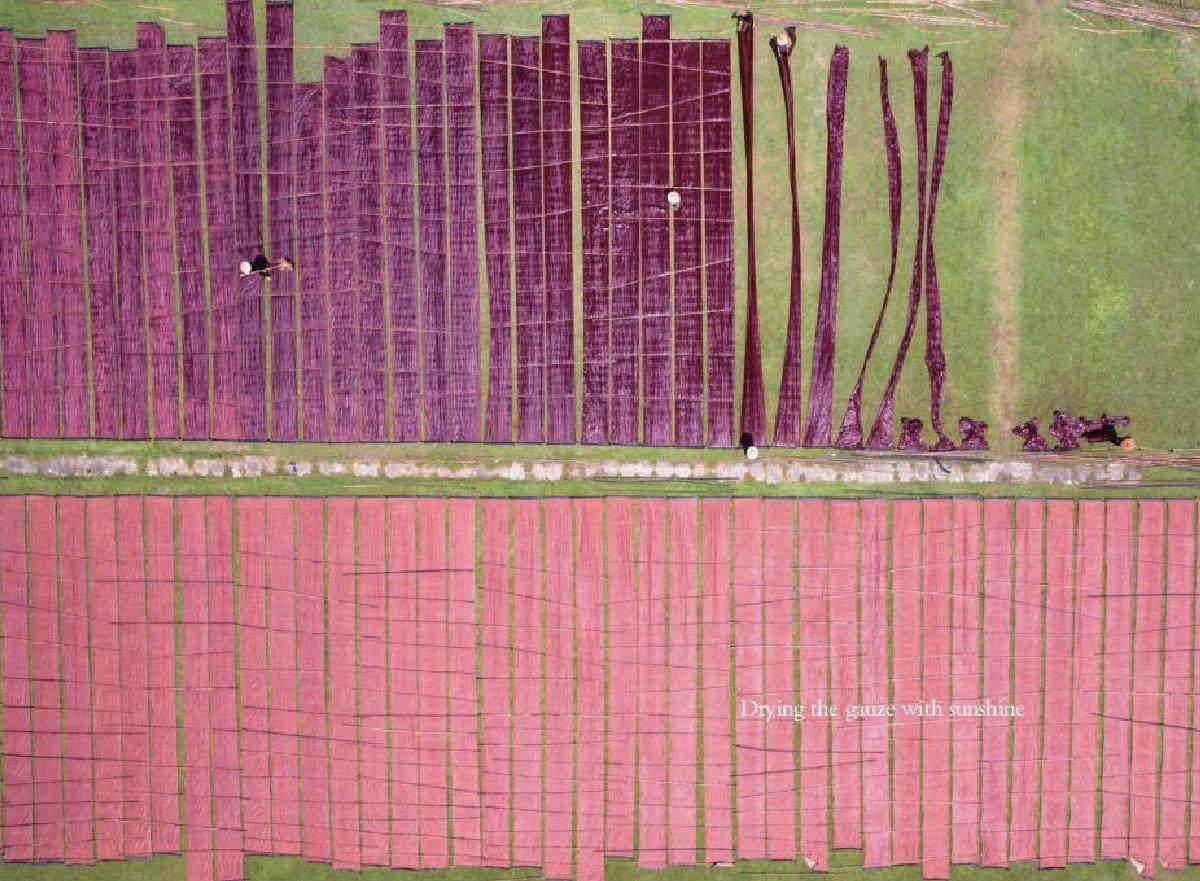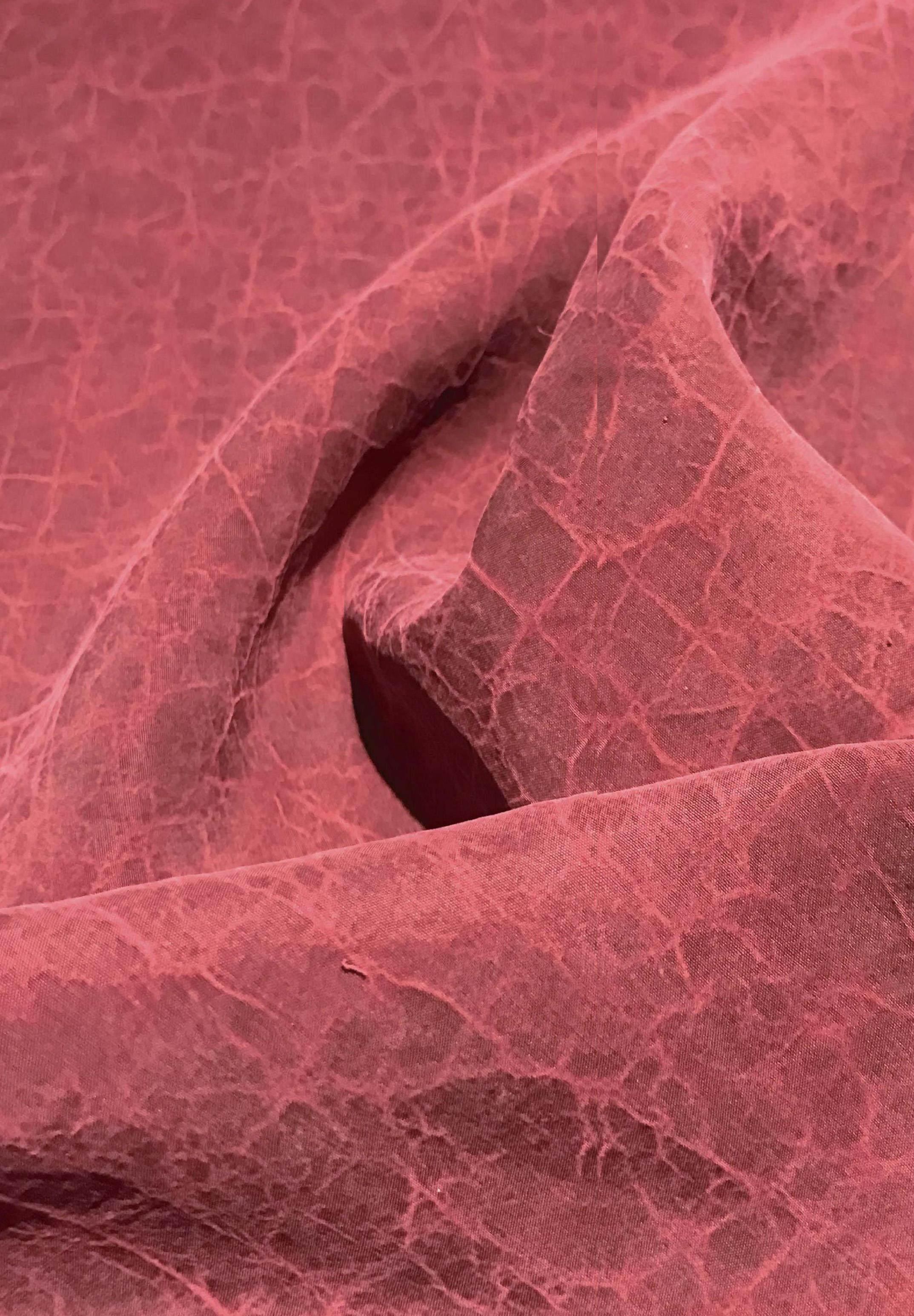Union of Heaven and Man -- the Dyeing and Finishing Process



As an important part of Chinese culture, Lingnan culture, mainly those in Guangdong province, plays a key role in the world culture. Elegant Guangdong Series cover five subjects of the Lingnan cultural and traditional gems in South China. Each volume has used vivid and precious illustrations and portraits. Gambiered Canton gauze outlines the birth, evolution, dyeing and finishing process, prospect of this ethereal silk fabric in South China.
Elegant Guangdong Series
Elegant Guangdong Series Editorial Board
Nanfang Daily Press
December 2020
100.00 (CNY)
Material: Naturally Endowed and Locally Sourced
The dyeing and finishing process of gambiered Canton gauze follows ancient technological requirements handed down for hundreds of years. The key factors include yam dye solution, river mud, and sunlight, which are naturally obtainable. The silk fabric ground on which gauze is made is woven with silk produced by silkworms. It is justifiable to say the gambiered Canton gauze is an artistic treasure endowed to the people living south of the Five Ridges by nature.
The silk greige could be classified into “the white silk greige” and “the white gauze greige” according to the texture and grain of the silk fabric ground. “The white silk greige” refers to plain weave texture or raw silk products. It is of fine and even texture; “guaze,” the folk name for which is “the white gauze greige,” refers to skein silk products woven with jacquard, which had been innovated by craftsmen from Nanhai County in the early years of the Republic of China, featuring fretwork of jacquard weave. The fabric has myriad pores, making it all the more fit for wear in the humid and sultry weather of the Guangdong area.
Yam dye is the tuber of a vine plant that grows in the remote mountains of subtropical regions and is most commonly seen in Guangdong and Guangxi. Its tuber skin is of dark brown color and bumpy appearance. If you cut it open, you will find that the inside is dark red or reddish yellow. The yam is widely used in traditional Chinese medicine. It can stop bleeding, relieve pain, and sterilize bacteria. Its tuber juice is rich in tannins, the basic dyeing material for gambiered Canton gauze.
For a long time, the gambiered Canton gauze could only be produced in Shunde, Nanhai, and other places in the Pearl River Delta area because there is another indispensable material for making the gambiered Canton gauze which is not ordinary river mud but unpolluted river mud with an iron element presence. This kind of mud is only available in rivers of the Pearl River Delta area. The river mud in these areas has not been polluted and is very fine and smooth. Therefore, although other countries have tried to produce gambiered Canton gauze in their own countries, they have all ended up in failure due to the fact that the river mud, the key material for forming the black and shiny coating on the gauze, cannot be replicated.
Making gambiered Canton gauze is a craft that depends on the elements. The silk impregnated with yam dye solution must be repeatedly exposed to the sun to allow the tannins in the yam juice to fully penetrate the white gauze greige and deposit a coating on the surface of the cloth. If it rains while drying, the rain will produce a piece of cloth unevenly colored. Only April to October is the time when the weather of Guangdong is fit for drying the gauze with long and adequate sunlight. In July and August, the sunshine is too strong and the temperature too high; in such weather, the gauze dried tends to be rigid and brittle, which is not the ideal time to commence production. While the dry northern monsoon wind blows southward in November, it is also unsuitable for drying the gauze. So, the time fit for drying the gauze is no more than four months in a year.
Procedures: Craftsmanship and Ingenuity
The dyeing and finishing technique of the gambiered Canton gauze is also called “gauze drying.” It consists of 14 main processes, including preparation of silk fabric ground, soaking with yam dye solution, drying, sealing solution, boiling and extracting, applying river mud, rinsing, stretching, spreading, rolling, packing, and warehousing. The entire process is complicated and cumbersome, relying entirely on manual work. It generally takes about 15 days to complete the whole process. Regardless it be the concentration of the yam dye solution or the number of times of drying and sealing, each process can only be adjusted by skilled craftsmen with reference to experience. The craftsman makes timely adjustments according to the specific situation, “varying adjustments on different weathers, different places, different workshops, different handling personnel,” which makes every bolt of gambiered Canton gauze unique in its own way.
There are key steps in the dyeing and finishing process of gambiered Canton gauze as follows:
The first step is preparing a yam dye solution. Grind the yam, immerse it in a trough to extract yam juice, filter out the yam dregs, and pour the solution into a large wooden barrel for later use. Different qualities and different weaving techniques have different requirements for the concentration of yam solution. The quality of prepared yam solution is the key to determining the quality of gambiered Canton gauze. There is no established standard for the concentration of the yam dye solution. The craftsmen in charge of preparation adjust the concentration according to the quantity of fabric to be dyed and finished and the speed of dyeing and finishing every day as they see fit. The concentration for a specific use relies exclusively on the experience of the craftsmen accumulated over the years, and there is no guidebook to refer to.
The second step is soaking and drying. A bolt of silk is cut into 20-meter pieces (fit for handling by one person) and placed in a sink filled with yam solution. The craftsman begins to stir the silk with his hands to make the silk fully soaked and absorb the yam solution evenly. The silk is then taken out of the tank and aired naturally, and then the silk is unfolded and straightened out on the lawn, exposed to the sun until dry.
After the silk is dried, the workers will spray yam solution on the silk from a bucket to make the dye more even. The sprayed yam solution will then be swept with a cattail broom to spread evenly on the silk fabric. The process of drying, soaking, and redrying will be repeated many times.
The point of drying silk on the grass is that the silk can absorb a certain amount of moisture from the grass when exposed to high temperatures, while the silk can be kept clean when it is away from soil and sand beneath the grass. The substantial temperature difference between the front and the back side of silk can enhance the “sharp-dull” contrastive effect of gambiered Canton gauze. Therefore, grass for such purpose must be soft, which will not scratch the silk fabric and can support a certain weight. Thus, the grass cultivated for drying gambiered Canton gauze is generally trimmed to 1--2 centimeters high. The local grass species with the folk name of “ground-crawling mouse” is fit for this purpose.
The third step is applying river mud. This process is key to the silk drying process. Extract river mud unique to the rivers of the Pearl river delta area, stir it into an evenly mixed paste, and apply the paste evenly on the front side of the silk with a specially-made mop. The silk covered with river mud is then lifted in a tightly stretched state to the grass by two workers. The silk then sits still for half an hour. This process can ensure that the high-valent iron ions in the river mud and the tannins in the yam solution induce sufficient chemical reactions to produce black precipitates that condense on the front side of the fabric. In eras prior to the creation of greenhouses, which can provide shade and shelter, in order to allow sufficient time for the chemical reaction to take place between river mud and silk, the “mud application” process had to be completed before sunrise.
After the mud application process, the silk must be moved to the river immediately to wash off the remaining river mud on the fabric, and then it will be spread flat on the grass again. At this time, the sun has just risen, and the early morning sun can dry the silk. By this time, the front side of the silk covered with river mud displays a black and oily appearance, adding a pottery-like luster, while the back side still remains reddish brown because it has not been exposed to the river mud.
The fourth step is to spread out the silk to absorb moisture. After the sun goes down in the evening, dew condenses and forms on the grass. At this time, the rigid silk fabric, after mud application and drying, is spread again on the grass to absorb moisture from the grass. The silk gradually softens. This process is called “spreading out for fog moisture absorption.”
Fog moisture absorption is the last process. However, the gambiered Canton gauze being processed thus far is still not yet the final product. After rolling, measuring, packing, and committing to the warehouse, it will sit in the warehouse for 3--6 months before being moved to the next step.
- 中國新書(英文版)的其它文章
- Internet Is Not a Good Thinking Tool
- Listening to One’s Inner Voice: Turning Feelings into Actions
- Urban Skylines
- Translation and Mutual Learning Among Civilizations
- The Significance of Preserving Craftsmanship: Reflecting on “Ingenious Craftsmanship” After Visiting Over 100 Artisans
- Traditional Folk Medicine and Pharmacology Series of the Ethnic Minorities in Yunnan Province -- The Yi Medicine and Pharmacology

